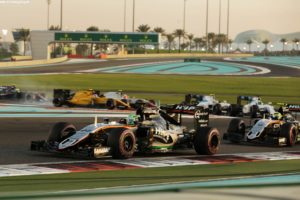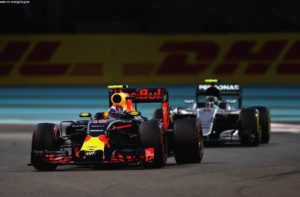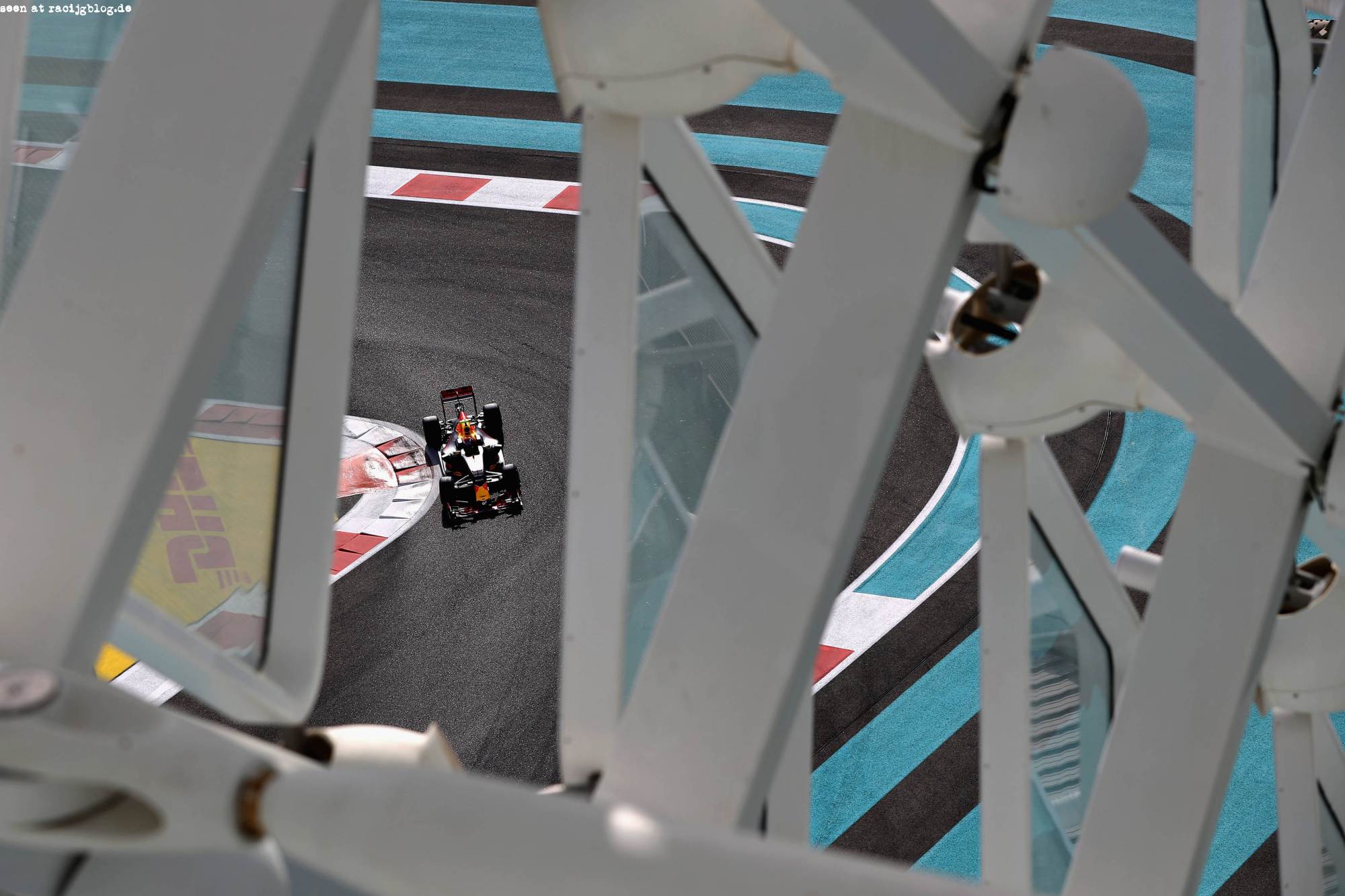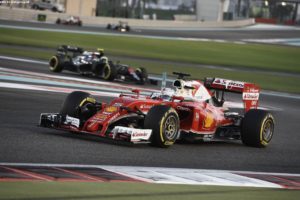The season finale was packed with drama and tension, especially at the end as Lewis Hamilton tried everything to change his situation and win the world championship.
 His personal strategy was clear, meanwhile team race strategy decisions had a huge bearing on what happened behind him, with Red Bull trying to win the race using a different strategy gambit, but getting caught out by some excellent work by Ferrari. The Scuderia beat Red Bull despite having a slower car, thanks to strategy. Here’s the inside track from strategists involved in the race, on how it all happened. With three tyres to choose from this year, many teams had prioritised the ultra soft for qualifying and the soft for the race. But having a new set of supersofts for the final stint of the race turned out to be a very beneficial strategy.
His personal strategy was clear, meanwhile team race strategy decisions had a huge bearing on what happened behind him, with Red Bull trying to win the race using a different strategy gambit, but getting caught out by some excellent work by Ferrari. The Scuderia beat Red Bull despite having a slower car, thanks to strategy. Here’s the inside track from strategists involved in the race, on how it all happened. With three tyres to choose from this year, many teams had prioritised the ultra soft for qualifying and the soft for the race. But having a new set of supersofts for the final stint of the race turned out to be a very beneficial strategy.
Red Bull decided to use theirs in the Q2 qualifying session, which meant that they would start the race on them. To do this and to forfeit the chance to have a new set of supersofts at the end meant that it was critical both drivers had a long and productive first stint. Many teams strategy models showed that a one stop strategy was possible starting on the Soft and then using the Supersoft at the end, a luxury not allowed for the top ten, who had to start on their qualifying tyres.
To do one stop starting on supersofts was possible, but right on the limit. Max Verstappen pulled it off superbly after dropping to the back at the start. Daniel Ricciardo was left wishing he had tried one stop too after losing out to Vettel and Verstappen at the end. Very stable conditions as always at Yas Marina led to ideal practice running for all teams and a clear picture of what the tyres would be capable of on race day.
Mercedes vs. Red Bull vs. Ferrari
What made this race unique was that Red Bull and Ferrari could be certain of one thing about Mercedes’ strategy: it would have to be conservative and fair to both drivers as they were fighting for a world championship. That meant a straight forward two stop strategy for both; ultrasoft – soft –soft.
 Knowing this meant that their rivals could seek to exploit it and there was a certain vulnerability to Mercedes for this race, even if they still had a modest car pace advantage in race conditions. Furthermore, it was clear that Lewis Hamilton would have to back his team mate Nico Rosberg into the pack at some point in the race, to try to get two cars between him and his rival and swing the points advantage his way. This was always likely to be towards the end of the race, when Rosberg would have no time or strategy options to recover.
Knowing this meant that their rivals could seek to exploit it and there was a certain vulnerability to Mercedes for this race, even if they still had a modest car pace advantage in race conditions. Furthermore, it was clear that Lewis Hamilton would have to back his team mate Nico Rosberg into the pack at some point in the race, to try to get two cars between him and his rival and swing the points advantage his way. This was always likely to be towards the end of the race, when Rosberg would have no time or strategy options to recover.
Knowing that, Ferrari went into this race better prepared than Red Bull and this was a race and a podium that they took away from Red Bull, which is pretty unusual for this season. Normally it is the other way around. Verstappen’s race was obviously compromised by the first lap spin he suffered and he had to negotiate quite a bit of traffic. He had considered a one-stop strategy anyway after qualifying a disappointing sixth on the grid, but the team went for it after losing so much ground.
After what happened on the opening lap, Ricciardo’s race should have been significantly further up the road than Verstappen’s but he finished behind him. Here is why.
It started when he lost a position at the start to Raikkonen. The superior grip off the line of the ultrasoft will have contributed to that.
Red Bull then got caught out by the conflict between what they normally do well, which is to be aggressive in the first stint and undercut other cars and what they were set up to do in this race, which is run a long first stint on supersoft. Ferrari spotted a gap to drop Vettel back into on Lap 8 when Kvyat and Button were fighting each other. Once that happened, Ricciardo needed to push for quite a few laps longer than the others he was racing against or he would have got nothing. Christian Horner said that a slightly flat spotted tyre compromised this plan, but Ricciardo played that down.
At this stage they had Verstappen one stopping and now in position ahead of Rosberg, Raikkonen and Vettel, which gave an ideal opportunity to have Verstappen hold back the Ferraris and Rosberg and make a gap for Ricciardo but instead of this, they pitted Ricciardo on Lap 9 and he lost all the advantage of qualifying on supersofts.
Verstappen’s performance showed that Ricciardo could have had much more flexibility in his strategy. He could have done a much longer first stint and then been prepared to attack at the end on fresher tyres, when Hamilton would be likely to hold up the field. This is what Vettel did after a long second stint.
After that their only chance to boost Ricciardo was to undercut Raikkonen at the second stop, which they did manage to do. He finished fifth, whereas second or third could have been possible and this would have really put pressure on Rosberg at the end!
So you could argue that in both Brazil on Verstappen’s car and in Abu Dhabi on Ricciardo’s, Red Bull made strategy errors that took their cars out of the way and helped Rosberg’s cause, inadvertently simplifying his path to the championship. It’s another aspect that shows that his name was clearly meant to be on the trophy this season!
Looking at the whole strategy approach in a different way; knowing that the lowering track temperatures as night falls always play to the strengths of the supersoft tyres and knowing Hamilton was likely to slow everything down at the end; there was a good chance of an attacking end on supersofts paying dividends. Both ways up, it is hard to avoid the conclusion that Red Bull picked the wrong strategy.
The Vettel strategy, which was opposed to Ricciardo’s, was clearly the right gambit. That is especially clear when you consider that the underlying pace demonstrated in Verstappen’s final stint was the fastest of any car on the track. So Ferrari beat Red Bull with a slower car; a positive way to end a very difficult season.
Alonso and McLaren try to ‘do a Vettel’
There was an interesting little cameo in the midfield, where Fernando Alonso and McLaren had the same idea as Ferrari and Vettel. It was another very strong drive by Alonso that didn’t get much attention. They were unlucky not to get past the Williams and Force India of Massa and Perez at the end as they also made the right moves with a long middle stint and an attacking supersoft stint at the end, like Vettel’s.
This is another example of how it’s important to remember that every car in the Grand Prix has a different equation; depending on how fast it is, where it is in the field and what the risks are in making a certain strategy call. Vettel was trailing the Red Bulls when he went for this tactic and Alonso was trailing the Williams and Force India. Both had nothing to lose by trying.
And that is an ideal way to end another season of F1 strategy analysis. We hope you have enjoyed it and look forward to next season’s action when the new cars designed to the more aggressive 2017 specification hit the track.


